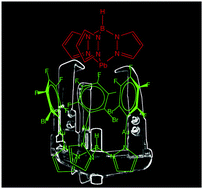Lead encapsulation by a golden clamp through multiple electrostatic, metallophilic, hydrogen bonding and weak interactions†
Abstract
The structure of the complex [{Pb(HBpz3)}{Au3(o-C6BrF4)3(HBpz3)}] consists of a host–guest heterometallic system built up through a plethora of interactions including electrostatic, metallophilic, H-bonding, Au⋯Br or weak C⋯C or Pb⋯Br contacts. Computational studies show that the dispersive interactions are responsible for the attraction of the Pb(II) cationic moiety within the basket-like trinuclear Au(I) fragment, whereas the ionic component of the interaction placed at the rings produces a molecular clamp.



 Please wait while we load your content...
Please wait while we load your content...